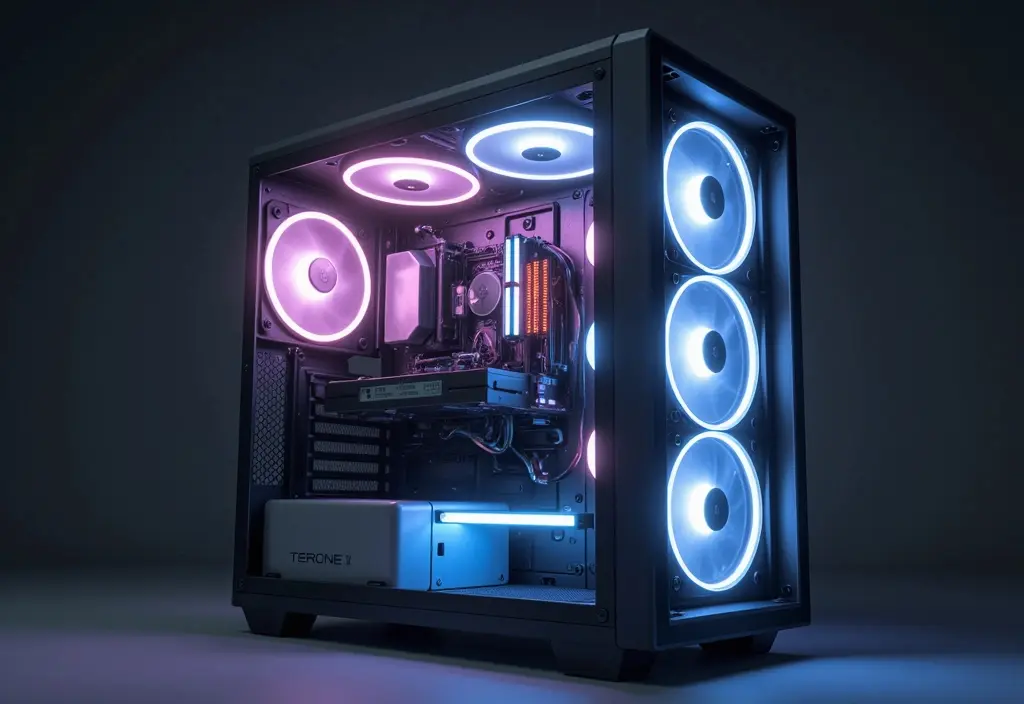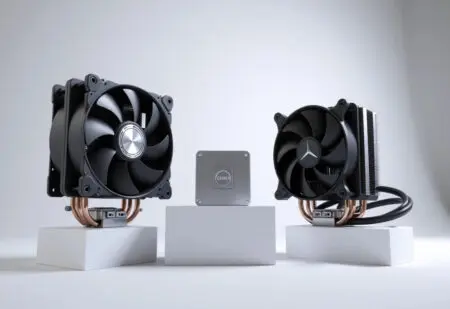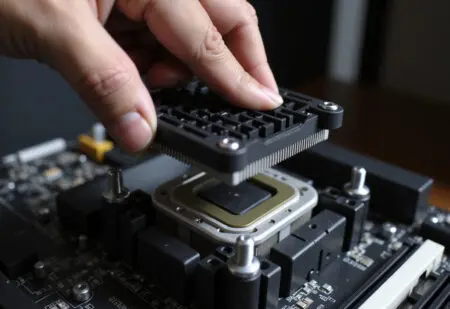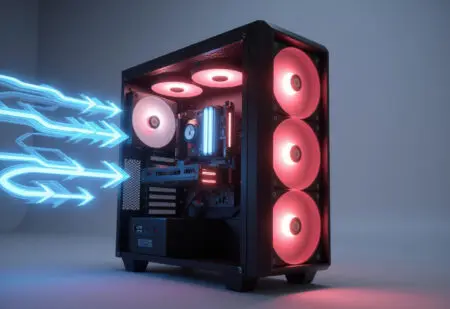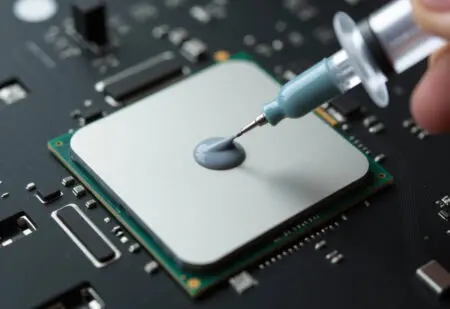Building a new gaming PC is an incredible rush. You spend weeks, maybe even months, picking out the perfect processor and a graphics card that can handle your favorite titles at silky-smooth frame rates. You agonize over memory speeds and storage capacity. But in the middle of all that excitement, there’s one question that often gets overlooked until the very end: How many case fans do I need for a gaming PC?
It seems simple, but the answer is more complex than just picking a number. Get it wrong, and that high-end hardware you just bought could end up performing worse than components half its price. I learned this the hard way. My first build was a monument to poor planning. I had a beast of a CPU and GPU for the time, stuffed into a cheap case that came with a single, lonely 80mm exhaust fan. I was wrong.
During intense firefights in Battlefield, my game would start to stutter and lag. My PC was screaming for help, but I couldn’t hear it over the single fan whirring at maximum speed. It was thermal throttling, a self-defense mechanism where your components slow down to avoid overheating. That experience taught me a vital lesson: cooling isn’t just an accessory; it’s the foundation of a stable and powerful gaming rig. This guide is everything I wish I had known back then.
More in Hardware Category
What Is the Best PC Case for Airflow
Air cooling vs. liquid cooling
Key Takeaways
- The Bare Minimum: For a budget or mid-range gaming PC, you should start with at least two case fans: one for intake at the front and one for exhaust at the rear.
- The Sweet Spot: Most gaming PCs will see optimal performance and temperatures with three to four fans. A common setup is two front intake fans, one rear exhaust, and sometimes an additional top exhaust.
- Placement Over Quantity: Where you put your fans and the direction they push air is far more important than the total number of fans. The goal is to create a consistent and efficient airflow path.
- Positive vs. Negative Pressure: Aiming for slightly more intake than exhaust (positive pressure) can help significantly reduce dust buildup inside your case.
- Size and Control Matter: Larger fans (like 140mm) can move more air more quietly than smaller fans (120mm). PWM (4-pin) fans offer superior speed control over DC (3-pin) fans, allowing for a quieter system.
So, What’s the Big Deal with Airflow Anyway?
Let’s get one thing straight. Every single component inside your computer generates heat. The CPU and GPU are the biggest offenders, acting like tiny, powerful space heaters. When you’re pushing your system hard in a demanding game, they get hot. Really hot. If that heat has nowhere to go, it builds up inside the case, raising the ambient temperature.
This is where things go south.
Your components are designed to operate within a specific temperature range. When they get too hot, they engage in that performance-killing behavior I mentioned: thermal throttling. To protect themselves from damage, they dramatically reduce their clock speeds. Suddenly, your 144 FPS drops to a choppy 40 FPS, and your gaming experience is ruined. This isn’t a defect; it’s a feature. But it’s a feature you never want to see.
Your CPU cooler and the fans on your graphics card are only part of the solution. They are designed to move heat away from the components themselves. But where does that hot air go? It gets dumped right into your PC case. The job of your case fans is to be the bouncers of this club. They kick the hot air out and bring the cool, fresh air in. Without them, your other cooling components are just blowing hot air around in a sealed metal box. It’s a recipe for disaster.
Before We Count Fans, What Are We Even Cooling?
The “right” number of fans isn’t universal because not all gaming PCs are built the same. The heat output of your specific components will be the single biggest factor determining your cooling needs. Before you start adding fans to your online shopping cart, you need to take a hard look at what’s actually inside your machine.
Is Your CPU Air-Cooled or Liquid-Cooled?
How you cool your processor directly impacts your case fan strategy. A traditional air cooler is a big heatsink with a fan strapped to it. It pulls heat from the CPU and dissipates it into the air inside your case. That hot air then needs to be immediately removed by an exhaust fan. If you’re using an air cooler, having a rear exhaust fan positioned right behind it is absolutely critical for performance.
On the other hand, an All-in-One (AIO) liquid cooler works a bit differently. It uses a pump to circulate liquid through a block on your CPU, absorbing the heat. This heated liquid then travels to a radiator, where fans blow air across it to cool the liquid down before it cycles back. Those radiator fans are essentially doing double duty. They’re cooling the liquid, but they’re also acting as either intake or exhaust fans for your case, depending on where you mount the radiator. A common AIO setup involves mounting the radiator at the top of the case as an exhaust, which is a highly effective way to expel heat directly.
How Hot Does Your Graphics Card Run?
The graphics card is often the single hottest component in a gaming PC. The difference in heat output between an entry-level card and a top-of-the-line beast is staggering. A card like an NVIDIA GeForce RTX 4060 might draw around 115 watts under load. In contrast, a flagship RTX 4090 can pull over 450 watts. That’s nearly four times the heat being dumped into your case.
If you’re running one of these power-hungry, high-end GPUs, you simply cannot get by with a minimalist fan setup. The card’s own fans will be working overtime to cool its heatsink, but all of that exhausted hot air needs to be dealt with by your case fans. For these builds, having strong intake fans at the front of the case is essential to supply the GPU with a constant stream of cool air. You need to get that heat out just as fast as the GPU is producing it.
Is There a “Magic Number” of Fans for a Gaming PC?
Okay, let’s get to the heart of the matter. While there isn’t a single magic number, we can establish some very solid baselines. For almost any PC that will be used for gaming, the absolute minimum you should consider is two fans. One fan for intake, usually at the front, and one fan for exhaust at the rear. This creates a basic airflow channel, pulling cool air over your components and pushing the hot air out the back. For a budget build with modest components, this is a perfectly acceptable starting point.
But the real sweet spot for most gaming builds is three fans.
This is the configuration I recommend to most people, and it’s what I use in my personal mid-range rigs. The setup is simple and incredibly effective: two 120mm or 140mm fans in the front as intakes, and a single fan in the rear as an exhaust. This setup ensures a steady supply of cool air is being fed directly to your GPU and CPU, and the rear exhaust efficiently removes the resulting hot air. It also tends to create positive air pressure, which we’ll talk about in a moment.
I remember the night I finally fixed my first, overheated build. After weeks of frustration, I went out and bought a simple two-pack of 120mm fans. I installed one in the front of my case, pulling air in, and replaced the tiny stock exhaust fan with the other. The difference was night and day. My temperatures dropped by over 15°C under load. Suddenly, my games were smooth again. I wasn’t throttling anymore. It felt like I had gotten a free hardware upgrade, all for the cost of two fans. That’s when I truly understood. It’s not about having a PC full of fans; it’s about having enough fans in the right places.
What’s More Important: The Number of Fans or Where You Put Them?
You could have ten fans in your PC, but if they’re all fighting each other or arranged improperly, you’ll have worse cooling than a well-planned two-fan setup. Placement and direction are everything. You need to create a clear, unobstructed path for air to travel through your case. Think of it like a wind tunnel for your components.
The Golden Rule: Intake Low, Exhaust High. Why?
The principle here is simple high school physics: hot air rises. You want to work with this principle, not against it.
- Intake Fans: These should be placed at the front and/or bottom of your case. They pull in the cooler, denser air from outside and push it across your motherboard, graphics card, and memory.
- Exhaust Fans: These should be located at the rear and/or top of your case. They take the hot air that has risen from your components and expel it from the system.
This front-to-back, bottom-to-top airflow path is the most efficient way to cool a standard PC. It ensures that the hot air generated by your CPU and GPU is quickly removed before it has a chance to be recirculated, keeping your components bathed in a constant supply of cool air.
What About Positive vs. Negative Pressure? Does It Actually Matter?
Yes, it absolutely matters, especially if you hate cleaning your PC. Air pressure inside your case is determined by the balance between your intake and exhaust fans.
- Positive Air Pressure: This occurs when you have more air being pushed into the case by your intake fans than is being pulled out by your exhaust fans. The excess air is then forced out through unfiltered cracks and vents. This is ideal because it significantly reduces how much dust gets sucked into your system.
- Negative Air Pressure: This is the opposite. You have more exhaust than intake. This creates a slight vacuum inside the case, which causes air (and dust) to be pulled in through every unfiltered opening. Your PC will cool effectively, but it will become a dust magnet.
I learned the value of positive pressure when I adopted two cats. Suddenly, my apartment had a constant supply of pet hair floating around. My PC, which had a balanced pressure setup, started getting clogged with fur. I decided to run an experiment. I added an extra intake fan to the front, creating strong positive pressure. The result? Six months later, when I opened the case for its scheduled cleaning, it was remarkably clean. The dust filters on the front panel were full, which told me they were doing their job, but the inside was nearly pristine. For anyone with pets or a dusty environment, a positive pressure setup is a game-changer.
Let’s Talk Specific Setups. How Many Fans for Your Build?
Now that we understand the principles, let’s apply them to some common build scenarios. Your hardware will dictate your needs, so find the category that best matches your gaming rig.
The Budget-Friendly Build: Can I Get Away with Just Two?
Absolutely. If you’re building a PC with an entry-level processor like an Intel Core i3 or an AMD Ryzen 3, paired with a modest graphics card, two fans are plenty. You aren’t generating a massive amount of heat, so you don’t need extreme airflow.
- Recommended Fan Count: 2
- Configuration: One 120mm intake fan at the front of the case, and one 120mm exhaust fan at the rear. This creates that simple, effective cross-case airflow that will keep your components happy without breaking the bank. Many quality budget cases even come with two fans pre-installed in this exact configuration.
The Mid-Range Sweet Spot: Is Three or Four the Ideal Number?
This is the category for the vast majority of gamers. You’re likely running a Core i5/Ryzen 5 or even a Core i7/Ryzen 7 processor, along with a solid mid-to-upper-tier graphics card like an RTX 4070 or RX 7800 XT. These components produce a significant amount of heat, and they need a bit more help.
- Recommended Fan Count: 3 to 4
- Configuration (3 Fans): Two 120mm or 140mm intake fans at the front, and one rear exhaust fan. This is the gold standard. It provides a strong flow of cool air directly to your main heat sources and creates beneficial positive air pressure.
- Configuration (4 Fans): Add one 120mm or 140mm exhaust fan to the top of the case, towards the rear. This helps exhaust the hot air rising from your CPU and VRMs even more efficiently.
The High-End Beast: Am I Crazy for Wanting Five or More?
No, you’re not crazy; you’re just cooling a furnace. When you’re running a top-of-the-line Core i9 or Ryzen 9 processor and a flagship GPU like an RTX 4090, you’re dealing with extreme thermal loads. These builds demand a high-airflow setup to maintain peak performance.
- Recommended Fan Count: 5+
- Configuration: Three 120mm intake fans at the front are almost mandatory. For exhaust, you’ll want one at the rear and at least one or two at the top. This creates a massive amount of airflow to tame those powerful components. Cases designed for this level of hardware, like the Fractal Design Meshify or the Lian Li O11 series, are built specifically to accommodate these multi-fan setups.
Does Fan Size Matter? Are Bigger Fans Better?
In the world of PC fans, size does matter. The two most common sizes you’ll encounter are 120mm and 140mm. While both get the job done, there’s a key difference in how they perform. A 140mm fan has a much larger blade surface area than a 120mm fan. This means it can move a similar volume of air (measured in CFM, or Cubic Feet per Minute) at a much lower rotational speed (RPM).
What does that mean for you? Noise.
Because they can spin slower to achieve the same cooling effect, 140mm fans are generally much quieter than their 120mm counterparts. If your goal is to build a powerful and quiet gaming PC, opting for 140mm fans wherever your case supports them is a fantastic choice. The trade-off is that they are slightly more expensive, and not all cases have mounts for the larger size. Always, always check your case specifications before buying fans to ensure they will fit.
What About PWM vs. DC Fans? Am I Overthinking This?
You’re not overthinking it, but the answer is pretty simple. When you shop for fans, you’ll see two main types based on their connectors: DC (3-pin) and PWM (4-pin).
- DC (Direct Current) Fans: These are the older standard. They have 3 pins: power, ground, and a tachometer signal to report their speed. The only way to control their speed is by having the motherboard lower the voltage sent to them. It works, but it’s less precise.
- PWM (Pulse Width Modulation) Fans: This is the modern standard. They have a fourth pin that carries a special signal, allowing for very precise and dynamic control over the fan’s speed.
PWM fans are the superior choice. Your motherboard can tell them to spin up gradually as temperatures rise and slow down when the system is idle. This results in a much quieter and more efficient system overall. Most modern motherboards have 4-pin fan headers, and PWM fans are not significantly more expensive. For any new build, they are the clear winner.
How Do I Know if My Fans Are Actually Working?
So you’ve installed your fans and your PC is up and running. How do you know if you did a good job? The proof is in the temperatures. You need to monitor your component temps to see if your airflow strategy is effective. You can use free and popular software like HWMonitor or MSI Afterburner to see real-time data for your CPU and GPU.
First, check your idle temperatures when you’re just sitting on the Windows desktop. For a CPU, anything in the 30-40°C range is great. For a GPU, 30-50°C is normal, as many modern cards have a zero-RPM mode where the fans don’t spin at idle.
The real test, however, is your load temperature. Fire up a demanding game and play for at least 30 minutes. While you’re playing, keep an eye on those temps. For both your CPU and GPU, you ideally want to stay below 85°C. Anything creeping into the 90s suggests your cooling is insufficient and you’re likely experiencing some degree of thermal throttling. If you see high temperatures, it might be time to add another fan or reconsider your current fan arrangement. For a deeper dive into the physics of how this all works, research on convective heat transfer, like that explored in various university engineering programs, can provide fascinating insights into the principles governing airflow in enclosed systems.
Finally, don’t underestimate the simple “hand test.” Carefully place your hand near your exhaust fans. You should feel a steady stream of warm air being pushed out. Then, place your hand near your intake fans. You should feel cool air being pulled in. It’s not scientific, but it’s a quick and easy sanity check to ensure your fans are pointed in the right direction.
Ultimately, figuring out the perfect cooling for your gaming PC is part of the fun of building it. It’s a system you’ve created. The answer to “how many fans do I need” isn’t a number you buy, but a balance you create. Start with the “sweet spot” of three fans, monitor your temperatures, and don’t be afraid to experiment. Mastering the airflow in your case is one of the most satisfying steps toward building a truly powerful and reliable gaming machine.
FAQ – How many case fans do I need for a gaming PC
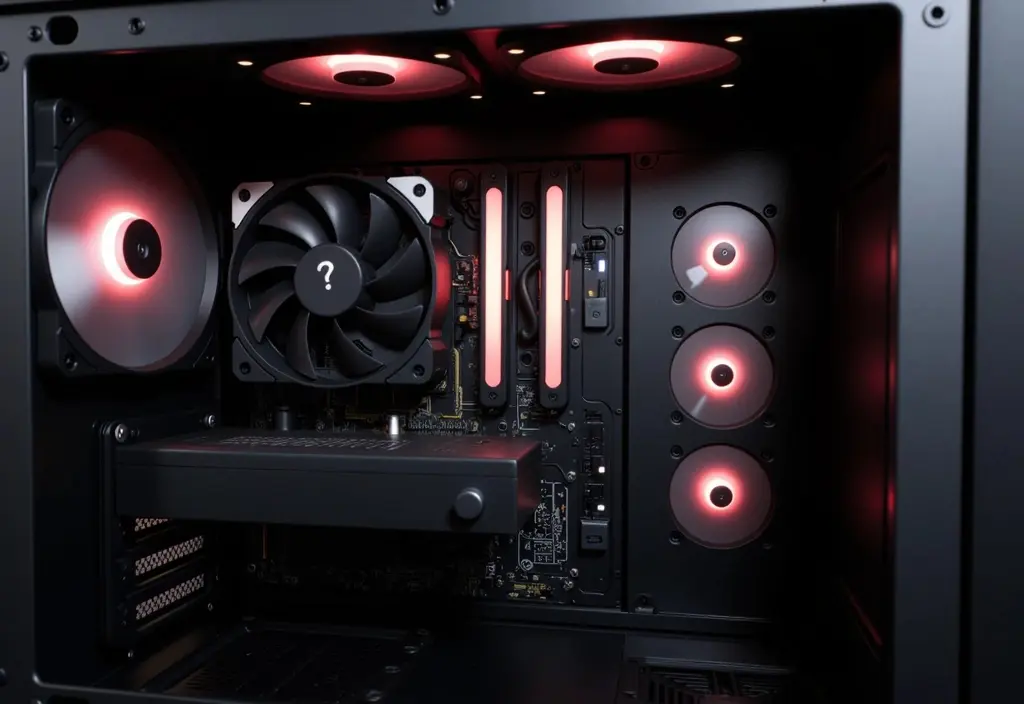
How do you choose the right number of fans based on your PC’s components?
The number of fans depends on the heat output of your components. Entry-level builds may need only two fans, mid-range builds benefit from three to four, and high-end, high-performance systems might require five or more fans for adequate cooling.
What is the difference between positive and negative air pressure in a PC case, and why does it matter?
Positive air pressure occurs when more air is pushed into the case than expelled, reducing dust buildup, while negative pressure pulls air (and dust) in through unfiltered cracks, increasing dust accumulation. Proper pressure setup can help keep your system cleaner and cooler.
Why is the placement and direction of case fans more important than their quantity?
The placement and airflow direction of case fans are more crucial than the number because they create an efficient and consistent airflow path, which is vital for effective cooling of components.
What is the optimal number of case fans for most gaming PCs?
Most gaming PCs see optimal performance and temperature management with three to four fans. A common setup includes two front intake fans and one rear exhaust fan, with an optional additional top exhaust for better heat dissipation.
How many case fans are recommended for a budget gaming PC?
For a budget or mid-range gaming PC, it is recommended to have at least two case fans, one for intake at the front and one for exhaust at the rear, to ensure proper airflow and cooling.

